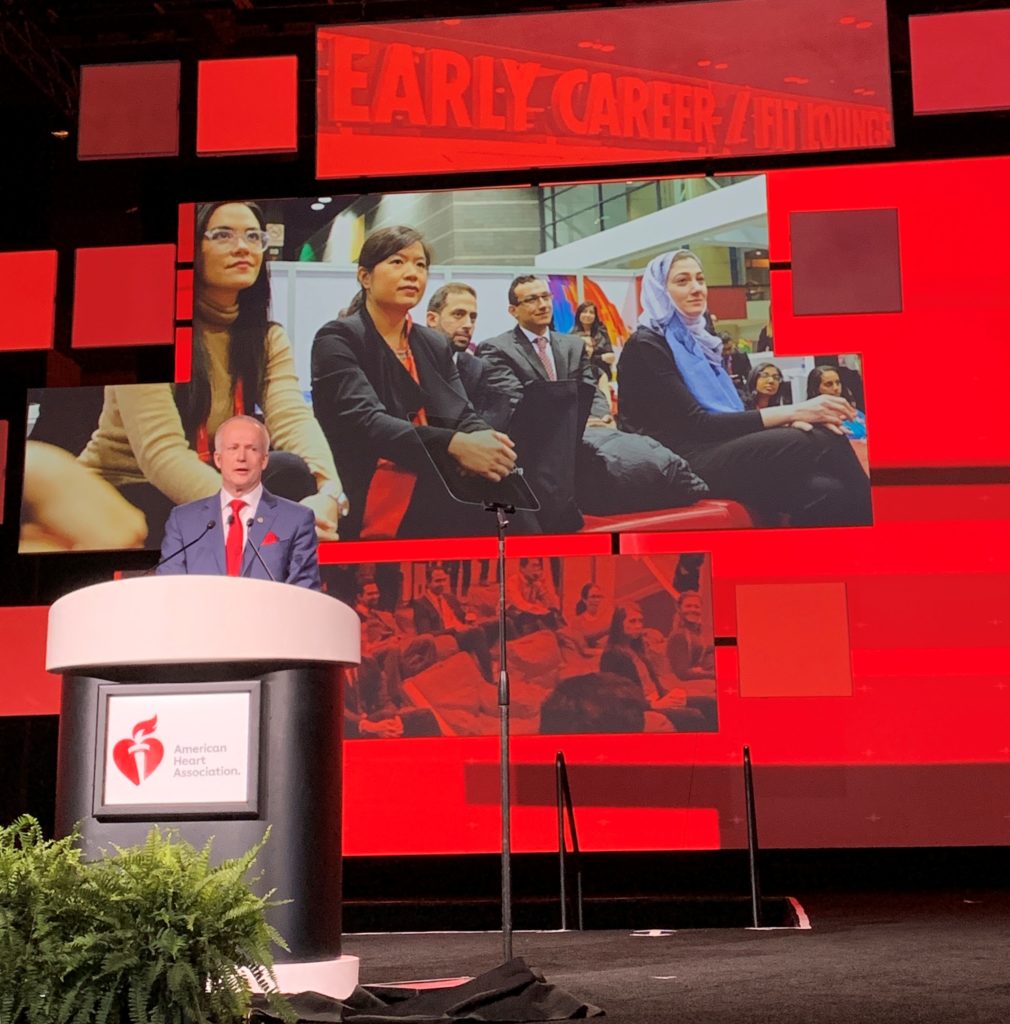AHA19 was a tremendous meeting for many reasons – extraordinary science, inspirational attendees, performances from the cast of Hamilton, and all in my current home of Philadelphia! Sessions 2019 was also unique for its deliberate approach to the inclusion of women in cardiovascular and neurovascular medicine. I was impressed by the breadth and depth of programming related to women and the open discussions of issues facing women in medicine. If you missed this thread of Sessions 2019, here are some highlights:

1) President Harrington’s Presidential Address: In AHA President Robert Harrington’s Presidential Address, he noted that over the last 7 years as a department and health system leader, he has become increasingly concerned with the lack of diversity in cardiovascular medicine. He also proclaimed that the male : female ratio in cardiovascular medicine is “out of whack” – a sentiment that drew rounds of applause from the audience. He shared some startling demographic data regarding the cardiovascular workforce, including the fact that 12 states have fewer than 10 practicing women cardiologists. The AHA’s newly formed Go Red for Women in Science and Medicine Committee is tackling implicit and explicit gender biases in all of its science activities, including grant submission and peer review processes. Dr. Harrington closed this part of his speech by emphasizing the imperative upon men in power to recognize and address these disparities in cardiovascular medicine. Despite lasting less than 5 minutes, this segment of his Address was captivating, and his impassioned case for diversity and inclusion drew multiple ovations from the audience.

2) No Manels: Dr. Harrington also announced that at AHA19 there were no all-male speaking panels, or “manels”! Earlier this year, the Director of the National Institutes of Health, Dr. Francis Collins, announced that he would no longer participate in manels or other events in which “inclusiveness is not evident in the agenda.” In his statement, he challenged other scientific leaders to do the same. When Dr. Harrington announced that he, Dr. Donald Lloyd-Jones, Dr. Manesh Patel, and AHA leadership had eliminated the manel at AHA19, I felt proud to be a part of an organization that prioritized this commitment to inclusivity in the scientific program and in a public way. The AHA has now set the standard for gender representation at cardiovascular conferences, and I am looking forward to where we go from here.

3) Women Across the Program: When I searched the word “women” in the AHA19 Sessions App, I found a total of 173 abstracts, oral presentations, luncheons, dinners, and Lounge sessions spanning career development, basic, translational, clinical, implementation, and population science. Not only were women leading at the podiums and panels, but there was an explosion of featured research in women’s cardiovascular health, cardio-obstetrics, sex differences in pathophysiology, diagnostics, therapeutics, and outcomes across the spectrum of cardiovascular disease. In addition, the Women in Science and Medicine Lounge hosted high-yield career development programming for women throughout the weekend with sessions on mentorship, sponsorship, volunteerism, social media, negotiations, storytelling, mindfulness, and more. In the AHA Fellow in Training (FIT) and Early Career Lounge, we held a fantastic session on self-advocacy as a woman in medicine with insights from Drs. Harriette Van Spall, Biykem Bozkurt, Mary Cushman, and Monika Sanghavi. In his Address, Dr. Harrington also announced a new AHA partnership called Research Goes Red, a technology platform powered by Verily and Project Baseline to engage 1,000,000 women to contribute their health data toward research into heart and brain health, with a focus on millennial women from underrepresented ethnic and racial groups.
In my advocacy work, I have learned that women are usually successful at engaging and empowering other women to support the mission of diversity and inclusion in cardiovascular medicine, but it is often easy for other populations to remain at a distance, divorced from and uninvested in these efforts. In many ways, AHA19 brought this dialogue to the center stage and demonstrated to our trainees and early career members that we are indeed making strides toward an equitable and just future for women in cardiovascular medicine.
The views, opinions and positions expressed within this blog are those of the author(s) alone and do not represent those of the American Heart Association. The accuracy, completeness and validity of any statements made within this article are not guaranteed. We accept no liability for any errors, omissions or representations. The copyright of this content belongs to the author and any liability with regards to infringement of intellectual property rights remains with them. The Early Career Voice blog is not intended to provide medical advice or treatment. Only your healthcare provider can provide that. The American Heart Association recommends that you consult your healthcare provider regarding your personal health matters. If you think you are having a heart attack, stroke or another emergency, please call 911 immediately.